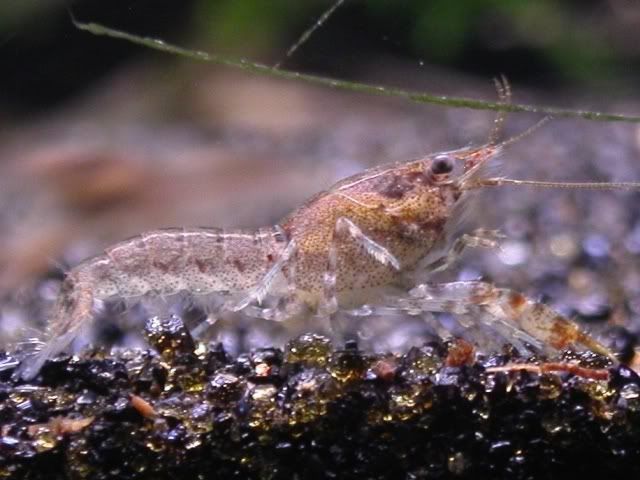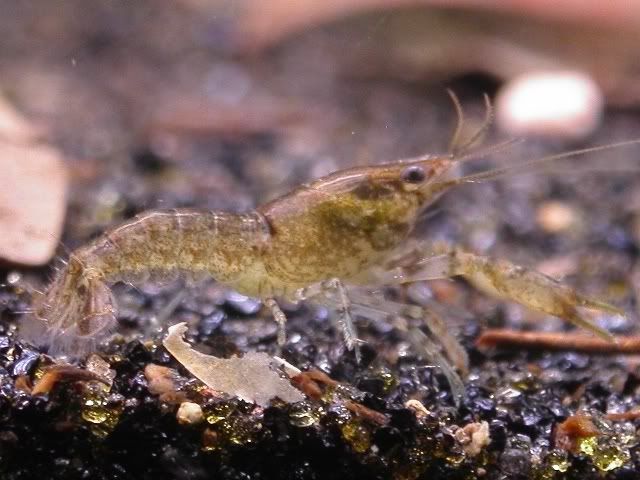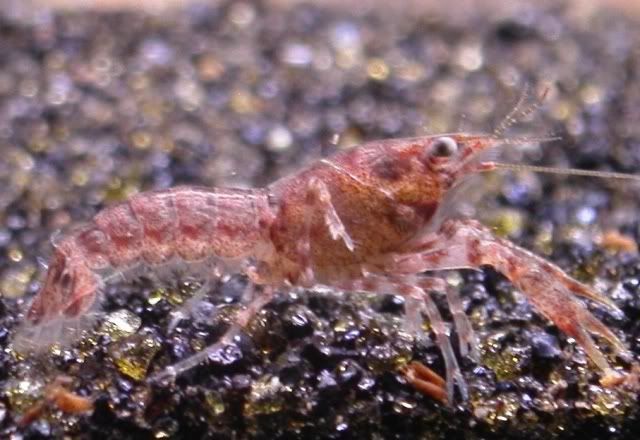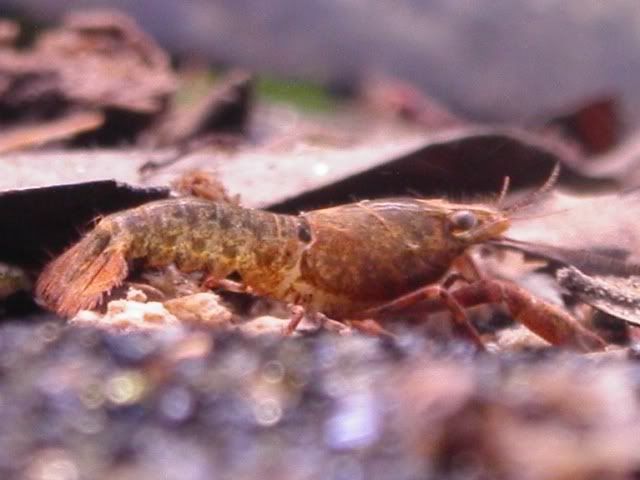Introducing: Cambarellus diminutus
Moderator: Mustafa
- YuccaPatrol
- Shrimp Master

- Posts: 600
- Joined: Sun Mar 12, 2006 4:41 pm
- Location: Burning-Ham, Alabama
With only two days to observe behavior, I don't have a lot to go on but here is what I have seen:
They seem non-aggressive. They will touch claws when two meet facing each other, but then go on their way. They do not seem too concerned with other crays being nearby as long as they are not face to face.
They are dominant over ghost shrimp twice their size.
I have not seen them burrow at all, but they do seek shelter under leaves or structure.
I have only seen them picking through decaying leaf litter and eating a piece of an algae wafer. Although the piece of wafer did get eaten, only one cray at a time was seen feeding.
I just took some photos under the microscope to help with the positive identification. I had to do it quickly because I did not want to harm the cray in the process, but I hope that these photos will be enough for comparison with the key.
I'll post the photos tonight.
They seem non-aggressive. They will touch claws when two meet facing each other, but then go on their way. They do not seem too concerned with other crays being nearby as long as they are not face to face.
They are dominant over ghost shrimp twice their size.
I have not seen them burrow at all, but they do seek shelter under leaves or structure.
I have only seen them picking through decaying leaf litter and eating a piece of an algae wafer. Although the piece of wafer did get eaten, only one cray at a time was seen feeding.
I just took some photos under the microscope to help with the positive identification. I had to do it quickly because I did not want to harm the cray in the process, but I hope that these photos will be enough for comparison with the key.
I'll post the photos tonight.
- CanadianCray
- <b>BANNED</b>
- Posts: 141
- Joined: Sun Jul 31, 2005 9:24 am
- Location: Burlington, Ontario, Canada
- The Fisherman
- Shrimpoholic

- Posts: 380
- Joined: Thu Sep 07, 2006 12:49 pm
- Location: G.R. Michigan
- Contact:
- YuccaPatrol
- Shrimp Master

- Posts: 600
- Joined: Sun Mar 12, 2006 4:41 pm
- Location: Burning-Ham, Alabama
Well, it took several hours to compare my specimens with the original species description, but I can now say that I am positive that the specimens I collected truly are Cambarellus diminutus. 
Here is one of my digital images next to a copy of an original diagram by H.H. Hobbs drawn in 1945 when he first described this species. Back then, he had to look into a microscope and then draw a flattened 2 dimensional interpretation of what he saw. Today, I am able to use a very nice dissecting scope and can easily enhance digital images to show maximum detail. Even better than that, I didn't have to kill this specimen in order to get the images I needed for a positive identification. This is one crayfish that is thankful for our digital age.
Of all the anatomical features I have examined today, these images are the easiest to interpret for a positive identification. Notice the shape of the rostrum, the spines just behind the eyes, and the spines further back on the cephalothorax.


Here is one of my digital images next to a copy of an original diagram by H.H. Hobbs drawn in 1945 when he first described this species. Back then, he had to look into a microscope and then draw a flattened 2 dimensional interpretation of what he saw. Today, I am able to use a very nice dissecting scope and can easily enhance digital images to show maximum detail. Even better than that, I didn't have to kill this specimen in order to get the images I needed for a positive identification. This is one crayfish that is thankful for our digital age.
Of all the anatomical features I have examined today, these images are the easiest to interpret for a positive identification. Notice the shape of the rostrum, the spines just behind the eyes, and the spines further back on the cephalothorax.

- Neonshrimp
- Master Shrimp Nut

- Posts: 2296
- Joined: Wed May 24, 2006 5:37 pm
- Location: California, USA
- YuccaPatrol
- Shrimp Master

- Posts: 600
- Joined: Sun Mar 12, 2006 4:41 pm
- Location: Burning-Ham, Alabama
His original diagrams are great. At first glance, it looks like the carapace in the diagram is wider than in the photograph, but the drawing is meant to show a flattened version of the real thing in order to depict the entire 3-D structure as a 2-D diagram. Imagine the diagram as a t-shirt laid flat and the photograph as one that is being worn.
Hmmm...the only inconsistency I see between the drawing and the photograph is that the rostrum in the photograph has much deeper "grooves" in the area that looks like a "crown" with three tips. Of course as the grooves are much deeper the outer two "tips" of the "crown" are much longer, too. It could of course be just intraspecific variation, but the difference is very noticable.
Last edited by Mustafa on Tue Sep 26, 2006 11:09 am, edited 1 time in total.
- YuccaPatrol
- Shrimp Master

- Posts: 600
- Joined: Sun Mar 12, 2006 4:41 pm
- Location: Burning-Ham, Alabama
You busted me, Mustafa! 
The diagram shows a form 1 male and the single specimen that I brought to the lab to photograph was discovered to be a female.
However, Fitzpatrick's 1983 revision of the dwarf crays noted that the original diagrams based on the form 1 male were inconsistent with later diagrams based on holotype specimens. He stated "The two groups of illustrations do not agree. Yet they are a fair representation of the range of variation encounted."
When my crays are compared with diagrams of the closely related species, it is obvious that they could not be anything but C. diminutus, despite some subtle differences between the diagrams and the photos.
There are some type specimens held at the Alabama Museum of Natural History which I plan to view in the future. Eventually, I will get the chance to photograph one of my males.
But yes, you and your attention to detail caught me!
The diagram shows a form 1 male and the single specimen that I brought to the lab to photograph was discovered to be a female.
However, Fitzpatrick's 1983 revision of the dwarf crays noted that the original diagrams based on the form 1 male were inconsistent with later diagrams based on holotype specimens. He stated "The two groups of illustrations do not agree. Yet they are a fair representation of the range of variation encounted."
When my crays are compared with diagrams of the closely related species, it is obvious that they could not be anything but C. diminutus, despite some subtle differences between the diagrams and the photos.
There are some type specimens held at the Alabama Museum of Natural History which I plan to view in the future. Eventually, I will get the chance to photograph one of my males.
But yes, you and your attention to detail caught me!
- YuccaPatrol
- Shrimp Master

- Posts: 600
- Joined: Sun Mar 12, 2006 4:41 pm
- Location: Burning-Ham, Alabama
I looked back through the photos and thought this one showed a better representation of the rostrum. I think the first segment of the antennules in thefirst photo seems to exaggerate the length of the outer points of the rostrum .
Interpreting species type diagrams can become a bit of an art when you have to consider interspecific variation, variation between sexes, and the limits of detail shown in the original diagrams.
Even with this more detailed photo, the right point on the rostrum is longer than the left, so there is still variation, but there are many more similarities than differences when many anatomical features are compared with closely related species.

Interpreting species type diagrams can become a bit of an art when you have to consider interspecific variation, variation between sexes, and the limits of detail shown in the original diagrams.
Even with this more detailed photo, the right point on the rostrum is longer than the left, so there is still variation, but there are many more similarities than differences when many anatomical features are compared with closely related species.

Thanks for the additional picture. I agree that the first photo might have played a trick on our eyes. This one resembles the diagram much more closely. And yes, I noticed the greater length of the right tip, too. Good eyes! 
I think we can finally conclude that this is C. diminutus. I, for one, have no doubt about it.
I think we can finally conclude that this is C. diminutus. I, for one, have no doubt about it.
- YuccaPatrol
- Shrimp Master

- Posts: 600
- Joined: Sun Mar 12, 2006 4:41 pm
- Location: Burning-Ham, Alabama
- Neonshrimp
- Master Shrimp Nut

- Posts: 2296
- Joined: Wed May 24, 2006 5:37 pm
- Location: California, USA
- ToddnBecka
- Shrimpoholic

- Posts: 363
- Joined: Wed May 24, 2006 11:12 pm
- Location: Western Maryland




